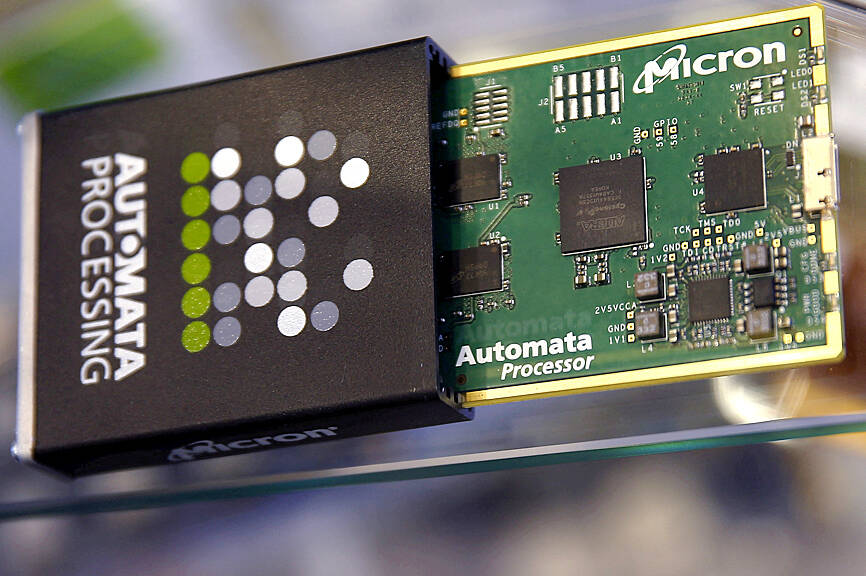The price of DRAM chips is expected to fall at a steeper rate of 13 to 18 percent next quarter, as high inflation continues to weigh on demand for consumer electronics, causing chip inventories to soar, market researcher TrendForce Corp (集邦科技) said yesterday.
The downtrend in DRAM prices could extend from a quarterly decline of 10 to 15 percent in the third quarter, the Taipei-based researcher said.
“Demand for consumer electronics continued to stagnate during the third quarter, which used to be a high demand season,” TrendForce said in a statement.

Photo: Reuters
“During the quarter, memorychip consumption and shipments both showed quarterly declines,” it said.
“As demand for memory chips slumped significantly, consumer electronics suppliers have been hesitant to place new orders. As such, chip suppliers are under mounting pressure to offload excessive inventory,” it said.
To sell more chips and to protect their market shares, some memorychip makers switched to a soft stance by consolidating price negotiations for the third and fourth quarters, or negotiating quantity before quoting prices, TrendForce said.
Chipmakers usually negotiate prices on a quarterly basis.
Prices of DRAM chips used in notebook computers are expected to drop 10 to 15 percent next quarter from the previous quarter as most suppliers refused to cut production, despite sluggish demand, the researcher said.
That is because DRAM chip makers still enjoy good profit margins, it said.
Prices of server DRAM chips are expected to tumble 13 to 18 percent next quarter, attributable to a delay in launches of new processors, TrendForce said.
Intel Corp is reportedly to postpone the launch of its new Intel 7-based server processors, dubbed Sapphire Rapids, to February or March next year.
Demand for server DRAM semiconductors has been sluggish as customers consume fewer chips, which has caused inventory to climb to nine to 12 weeks, surpassing normal levels of six to eight weeks, the researcher said.
Demand from server makers and cloud service providers in China and the US all stagnated, it said.
Mobile DRAM chip prices are expected to slide 13 to 18 percent next quarter, TrendForce said.
The decline could accelerate further, given that mobile phone vendors continued to cut sales forecasts amid a gloomy outlook, it said.
Excessive inventory at the level of seven to nine weeks also crimped chip demand, it added.
Facing similar issues of slowing demand and mounting inventory, memorychip makers are expected to experience quarterly price declines of 10 to 15 percent for graphics DRAM and consumer electronics DRAM chips, TrendForce said.

Application-specific integrated circuit designer Faraday Technology Corp (智原) yesterday said that although revenue this quarter would decline 30 percent from last quarter, it retained its full-year forecast of revenue growth of 100 percent. The company attributed the quarterly drop to a slowdown in customers’ production of chips using Faraday’s advanced packaging technology. The company is still confident about its revenue growth this year, given its strong “design-win” — or the projects it won to help customers design their chips, Faraday president Steve Wang (王國雍) told an online earnings conference. “The design-win this year is better than we expected. We believe we will win

Intel Corp chief executive officer Lip-Bu Tan (陳立武) is expected to meet with Taiwanese suppliers next month in conjunction with the opening of the Computex Taipei trade show, supply chain sources said on Monday. The visit, the first for Tan to Taiwan since assuming his new post last month, would be aimed at enhancing Intel’s ties with suppliers in Taiwan as he attempts to help turn around the struggling US chipmaker, the sources said. Tan is to hold a banquet to celebrate Intel’s 40-year presence in Taiwan before Computex opens on May 20 and invite dozens of Taiwanese suppliers to exchange views

Chizuko Kimura has become the first female sushi chef in the world to win a Michelin star, fulfilling a promise she made to her dying husband to continue his legacy. The 54-year-old Japanese chef regained the Michelin star her late husband, Shunei Kimura, won three years ago for their Sushi Shunei restaurant in Paris. For Shunei Kimura, the star was a dream come true. However, the joy was short-lived. He died from cancer just three months later in June 2022. He was 65. The following year, the restaurant in the heart of Montmartre lost its star rating. Chizuko Kimura insisted that the new star is still down

While China’s leaders use their economic and political might to fight US President Donald Trump’s trade war “to the end,” its army of social media soldiers are embarking on a more humorous campaign online. Trump’s tariff blitz has seen Washington and Beijing impose eye-watering duties on imports from the other, fanning a standoff between the economic superpowers that has sparked global recession fears and sent markets into a tailspin. Trump says his policy is a response to years of being “ripped off” by other countries and aims to bring manufacturing to the US, forcing companies to employ US workers. However, China’s online warriors